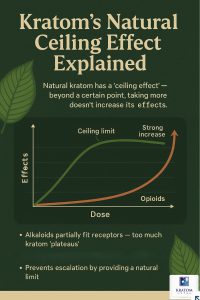🌿 Why Your Body Knows When Enough Is Enough
Kratom (Mitragyna speciosa) continues to intrigue scientists and wellness enthusiasts alike for its ability to energize, relax, and restore balance — all without the dangerous side effects found in synthetic substances. One of the most remarkable things about kratom is its natural “ceiling effect.” Beyond a certain point, taking more kratom doesn’t increase its effects. Kratom’s natural ceiling affect means it simply plateaus. This built-in safety feature is part of what makes kratom unique, helping prevent respiratory suppression and overdose.
🔑 Key Points
-
Kratom’s ceiling effect limits how strongly its alkaloids activate receptors.
-
This helps prevent overdose and respiratory depression.
-
The effect comes from partial agonism at mu-opioid receptors.
-
Unlike opioids, kratom has a self-limiting pharmacology that promotes balance, not escalation.
-
The plant’s dual nature and natural ceiling make it safer for responsible use.
🧬 The Science Behind the Ceiling Effect
 Kratom’s key alkaloids — mitragynine and 7-hydroxymitragynine — interact with several receptor systems in the body, including mu-opioid receptors. However, they do so in a partial and selective way.
Kratom’s key alkaloids — mitragynine and 7-hydroxymitragynine — interact with several receptor systems in the body, including mu-opioid receptors. However, they do so in a partial and selective way.
Where opioids like morphine are full agonists (fully activating the receptor and flooding the brain’s reward system), mitragynine is a partial agonist. It “fits” into the receptor but only partially turns it on, producing milder, safer effects.
As the dose increases, the receptors don’t become more active — they reach a functional limit. This built-in biological boundary is the ceiling effect.
Studies published in The National Library of Medicine show that kratom’s alkaloids have a ceiling for respiratory and euphoria-inducing effects, which dramatically reduces overdose risk compared to full opioids.
⚖️ How Kratom’s Ceiling Differs from Opioids
| Feature | Kratom (Mitragynine) | Opioids (Morphine, Fentanyl, etc.) |
|---|---|---|
| Receptor Activity | Partial agonist | Full agonist |
| Overdose Risk | Extremely low | High |
| Breathing Suppression | None | Severe |
| Reward System | Limited activation | High, addictive activation |
| Safety Mechanism | Built-in ceiling effect | No natural limit |
This is why kratom is often described as self-regulating — the body and plant work together to maintain equilibrium. The more you take, the less additional effect you get.
🌿 Why the Ceiling Effect Matters for Safety
The ceiling effect makes kratom distinct among plant-based wellness tools. It:
-
Prevents escalation: Users can’t “chase” stronger effects because the body’s receptors stop responding beyond a certain threshold.
-
Supports balance: The alkaloid interaction naturally tapers the experience, creating calm without sedation.
-
Reduces risk: Because breathing and heart rate aren’t suppressed, kratom has not been shown to cause fatal overdoses when used responsibly.
Even at higher doses, kratom’s partial receptor binding prevents the dangerous spirals associated with opioids or synthetic depressants.
⚗️ The Role of Mitragynine and 7-Hydroxymitragynine
Kratom’s two main active compounds work together in a unique chemical balance:
-
Mitragynine (major alkaloid): Provides stimulating, mood-lifting, and focus-enhancing effects. It’s the primary driver of kratom’s safety ceiling because of its partial receptor action.
-
7-Hydroxymitragynine (minor alkaloid): Offers more soothing properties but is present in extremely small amounts in natural kratom leaf — typically less than 0.02%.
Because these two compounds coexist in natural ratios, the plant cannot trigger the intense euphoria or respiratory suppression that synthetic drugs cause.
🧪 Lab Testing: The Key to Natural Balance
To maintain kratom’s natural ceiling effect, purity is essential. At KratomUSA, every batch undergoes third-party laboratory testing to confirm:
-
Accurate mitragynine-to-7-hydroxymitragynine ratios
-
No synthetic adulteration or concentration manipulation
-
Clean, safe, and natural plant balance
This ensures your kratom behaves exactly as nature designed — gentle, balanced, and self-limiting.
💬 What Real Users Say
“I love that kratom helps me relax without ever feeling out of control. I can tell when I’ve had enough because the effects naturally level off.” — Carla R.
“Other substances made me feel like I needed more and more to get relief. With kratom, I just don’t feel that way.” — Evan S.
“The ceiling effect makes me feel safe. It gives comfort without the danger.” — Melissa G.
❓ FAQ
Q: What does “ceiling effect” mean in plain terms?
A: It means there’s a natural limit to how much effect kratom can produce. Beyond that point, taking more doesn’t increase intensity — your body simply plateaus.
Q: Why is this a good thing?
A: Because it keeps kratom use safe and stable, preventing respiratory issues or dangerous overdoses.
Q: Does this mean kratom can’t be abused?
A: While anything can be misused, kratom’s self-limiting chemistry makes it far less likely to produce addiction or harmful escalation.
Q: Can the ceiling effect vary by strain?
A: Slightly — alkaloid ratios differ by color and growing region, but the ceiling property is consistent across all natural kratom.
🌿 Final Thoughts
Kratom’s natural ceiling effect is one of its most powerful and protective features. It demonstrates how this ancient botanical supports the body’s natural balance — providing relief, calm, and focus without danger.
While synthetic substances override the body’s limits, kratom works within them.
It’s a plant that knows when enough is enough — a safety mechanism built by nature itself. 🌿
For clean, lab-tested kratom that retains this natural ceiling effect, explore trusted strains at KratomUSA.com.


